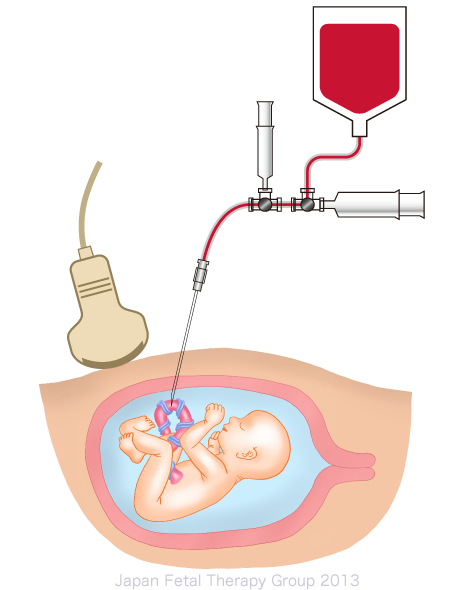Last Updated:19 5月. 2014
Fetal anemia
What is the cause of fetal anemia?+ SHOW
The most common cause of severe fetal anemia is blood type incompatibility in pregnancy. In typical cases this is to do with Rh blood group, where the mother is Rh(D) negative, and the fetus is Rh(D) positive, and the mother’s body produces D antibodies, causing hemolytic anemia in the fetus. Human parvovirus B19 infection (“slapped cheek disease”), among other conditions, can also cause fetal anemia.
How is fetal anemia diagnosed?+ SHOW
Fetal anemia is diagnosed by fetal blood sampling and Doppler evaluation of fetal middle cerebral artery peak systolic velocity.(1) Ultrasound is non-invasive and can be implemented repeatedly, but can only provide insight into indirect symptoms. Fetal blood sampling from the umbilical vein under the guidance of ultrasound allows for a confirmed diagnosis.
What is fetal transfusion?+ SHOW
When fetal anemia is diagnosed, red blood cells are transfused for fetus. One of the most successful fetal therapies in existence, the current method of transfusion via the umbilical vein under the guide of ultrasound has been used since the 1980s.
What treatment is generally used for fetal anemia, other than fetal transfusion?+ SHOW
Other therapies involve waiting for the maturation of the fetus, or delivering the baby early and providing it intensive treatment, including transfusion. Since in general, fetal anemia is progressive, the condition of patients tends to worsen while under observation, and early delivery can also bring problems caused by prematurity.
What is the history of fetal transfusion?+ SHOW
From a historical perspective, fetal transfusion was the first genuine “fetal therapy.” It dates back to a first report by Liley in 1963(2), who transfused blood into the abdominal cavity of a fetus under X-ray guidance in a case of Rh incompatible pregnancy. The current method of transfusing via the umbilical vein using ultrasound as a guide has been in use since 1982(3). In Japan, the first such treatment of Rh incompatible pregnancy with fetal anemia was implemented at Tohoku University.(4)
How is fetal transfusion implemented?+ SHOW
Local anesthetic is applied to the point at which the abdominal wall of the mother is to be punctured, and the umbilical vein is punctured under ultrasound guidance. Depending on the situation, transfusion may also be implemented into the abdomen of the fetus. Type O Rh-negative blood, which has been confirmed as carrying no infection, is transfused in the calculated quantity (Fig. 1). ‘A few cases are accompanied by complications such as fetal bradycardia, blood loss from the puncture, fetal heart failure, infection, early membrane rupture or premature delivery, etc. Fetal transfusion can only be carried out at a facility capable of conducting the procedure, since it requires technical expertise.

Fig. 1
What is the outcome and prognosis of fetal transfusions?+ SHOW
Prognosis depends on the cause of the fetal anemia, but a report of 254 cases of fetal anemia(5) , to which fetal transfusion was administered a total of 740 times, provided excellent treatment results, with a survival rate of 89%.
References+ SHOW
1.Oepkes D, et al: The use of ultrasonography and Doppler in the prediction of fetal hemolytic anemia: a multivariate analysis. Br J Obstet Gynecol 1994;101:680-684
2.Liley AW: Intrauterine transfusion of foetus in haemolytic disease. Brit Med J ii:1107-1109, 1963
3.Bang J, et al: Ultrasound-guided fetal intravenous transfusion for severe rhesus haemolytic disease. Brit Med J 284;373-374, 1982
4.Tanigawara S, Okamura K, et al: Intrauterine intravascular fetal transfusion under ultrasonic guide in Rhisoimmunization: a case report. Nihon Sanka Fujinka Gakkai Zasshi. 1989; 41(5): 621-624
5.van Kamp IL, et al: Complications of intrauterine intravascular transfusion for fetal anemia due to maternal red-cell alloimmunization.Am J Obstet Gynecol 2005; 192: 171-177

